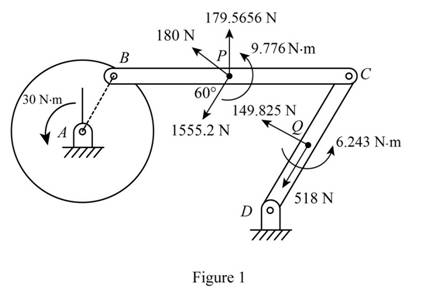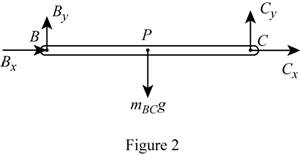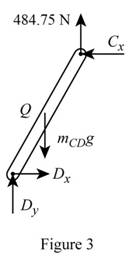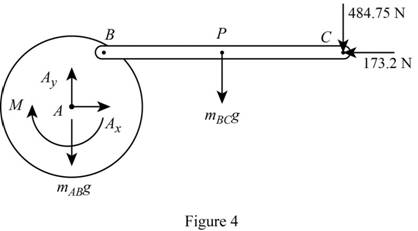
Concept explainers
(a)
Find the couple M.
(a)
Answer to Problem 16.136P
The couple M is
Explanation of Solution
Given information:
The mass of the rod BC is
The mass of the disk is
The mass of the rod CD is
The angular velocity is
The angular acceleration is
Calculation:
Consider the acceleration due to gravity as
Calculate the velocity of disk AB
Substitute
Calculate the velocity of rod BC
The velocity of disk AB is equal to the velocity of rod BC.
Substitute
Calculate the angular velocity of rod CD
Substitute
Apply the acceleration analysis as shown below.
Calculate the acceleration for disk AB
Substitute
Calculate the acceleration for rod BC
Substitute
Calculate the acceleration for rod CD
Substitute
Equating the components of Equations (1) and (2) as shown below.
Along x component.
Along y component.
Substitute
Calculate the acceleration of the mass centers as shown below.
Calculate the acceleration of mass center for disk AB
Calculate the acceleration of the mass center at P for rod BC
Substitute
Substitute
Calculate the acceleration of the mass center at Q for rod CD
Substitute
Calculate the inertial terms at mass centers as shown below.
The inertia terms at centers are
For disk AB.
For rod BC.
Substitute
For rod CD.
Substitute
Calculate the mass moment of inertia
For disk AB.
Substitute
For rod BC.
Substitute
For rod CD.
Substitute
Calculate the effective couples at mass centers as shown below.
The inertia terms at centers are
For disk AB.
For rod BC.
Substitute
For rod CD.
Substitute
Sketch the effective force and couples on the system as shown in Figure 1.

Sketch the Free Body Diagram of the rod BC as shown in Figure 2.

Refer to Figure 2.
Apply the Equilibrium of moment about B as shown below.
Substitute
Sketch the Free Body Diagram of the rod CD as shown in Figure 3.

Refer to Figure 3.
Apply the Equilibrium of moment about D as shown below.
Substitute
Sketch the Free Body Diagram of the rod AB and BC as shown in Figure 4.

Refer to Figure 4.
Apply the Equilibrium of moment about A as shown below.
Substitute
Therefore, the couple M is
(b)
The components of force exerted at C on rod BC.
(b)
Answer to Problem 16.136P
The components of force exerted at C on rod BC is
Explanation of Solution
Given information:
The mass of the rod BC is
The mass of the disk is
The mass of the rod CD is
The angular velocity is
The angular acceleration is
Calculation:
Refer to part (a).
The components of force exerted at C on rod BC along x direction is
The components of force exerted at C on rod BC along y direction is
Therefore, the components of force exerted at C on rod BC is
Want to see more full solutions like this?
Chapter 16 Solutions
VECTOR MECHANIC
- Qu 2 Calcium oxide (CaO) a white, caustic, alkaline solid that reacts vigorously with water to produce calcium hydroxide, releasing heat in the process. It is used in various industrial applications, including cement production and water treatment. FA= 41{0 The ionic radii of the ions are: TCa2+= 0.100 nm and roz-= 0.140 nm. On the basis of this information answer the following questions: 1. What is the type of bonding that exists in CaO crystal? 2.Calculate attractive (Fs) force in [N] between a Ca'* iron and O* ifon that is separated by an equilibrium distance ro. Calculate repulsive (FR) force in [N] between a Ca?* iron and O? iron that is separated by an equilibrium distance ro. What is the magnitude of the net force FN?arrow_forwardShow work if any equations or calculations are used.What is the main alloying element and carbon percentage of SAE-AISI 4621 Steel?arrow_forwardThe particle has a mass of 0.5 kg and is confined to move along the smooth horizontal slot due to the rotation of the arm OA. Determine the force of the rod on the particle and the normal force of the Isot on the particle when 0 = 30°. The rod is rotating with a angular velocity of ė = 2rad/s and an angular acceleration of = 3rad/s². Assume the particle only contacts one side of the slot at any instant. To check your answer, please enter the normal force of the slot onto the particle in Newtons. A * = 2 rad/s -0- 0.5 marrow_forward
- Solve, use engineering economic tablesarrow_forwardSolve, use engineering economic tablesarrow_forwardQu 2 Calcium oxide (CaO) a white, caustic, alkaline solid that reacts vigorously with water to produce calcium hydroxide, releasing heat in the process. It is used in various industrial applications, including cement production and water treatment. The ionic radii of the ions are: TCa2+= 0.100 nm and roz-= 0.140 nm. On the basis of this information answer the following questions:Number 1 through 4 I need to show all work step by step problemsarrow_forward
- Show work if any equations or calculations are used. Assuming hole basis, find the shaft and hole dimensions for a sliding fit using a basic hole size of 20mm. Show the max and minimum size for both hole and shaft. Utilize the equations and tables in the appendix.arrow_forwardShow work if any equations or calculations are used. A milling machine is equipped with a 1” diameter end mill. During a facingoperation, the spindle is running at 275 RPM. The depth of cut is 0.04” and linear feed rate is 2” per minute. Find: (a) Cutting speed, (b) Material Removal Ratearrow_forwardL1 = 5.7m, L2 = 1m, L3 = 1.2m, L4 = 1m, L5 = 0.2, L6 = 0.5m, v2 = 4.8m/s. The solutions should include, but not be limited to, the equations used tosolve the problems, the charts used to solve the problems, detailed working,choice of variables, the control volume considered, justification anddiscussion of results etc.If determining the friction factor, the use of both Moody chart and empiricalequations should be used to verify the validity of the valuearrow_forward
- Please identify the marked points of the stress-strain curve (Write on graph next to corresponding letter) Stress, σ A D (slope of line) B. C Strain, &arrow_forwardr Q2. A bracket is attached to a vertical column by means of six identical bolts as shown in Fig. 1. It is subjected to an eccentric force of P-80 kN at a distance of 200 mm from the center of column. What is the magnitude of maximum shear force and which bolt carry it? P= 80 kN 200 Fig. 1 1 2- 75 6 30 75 → 5 .5 1- 50 10-50-1arrow_forward3. The attachment shown in the Fig.2 is made of 1040 HR. The static force is 30 kN. Specify the weldment (give the pattern, electrode number, type of weld, length of weld, and leg size). 30 kN Fig. 2 500 All dimension in mm 100 (15 marks)arrow_forward
 Elements Of ElectromagneticsMechanical EngineeringISBN:9780190698614Author:Sadiku, Matthew N. O.Publisher:Oxford University Press
Elements Of ElectromagneticsMechanical EngineeringISBN:9780190698614Author:Sadiku, Matthew N. O.Publisher:Oxford University Press Mechanics of Materials (10th Edition)Mechanical EngineeringISBN:9780134319650Author:Russell C. HibbelerPublisher:PEARSON
Mechanics of Materials (10th Edition)Mechanical EngineeringISBN:9780134319650Author:Russell C. HibbelerPublisher:PEARSON Thermodynamics: An Engineering ApproachMechanical EngineeringISBN:9781259822674Author:Yunus A. Cengel Dr., Michael A. BolesPublisher:McGraw-Hill Education
Thermodynamics: An Engineering ApproachMechanical EngineeringISBN:9781259822674Author:Yunus A. Cengel Dr., Michael A. BolesPublisher:McGraw-Hill Education Control Systems EngineeringMechanical EngineeringISBN:9781118170519Author:Norman S. NisePublisher:WILEY
Control Systems EngineeringMechanical EngineeringISBN:9781118170519Author:Norman S. NisePublisher:WILEY Mechanics of Materials (MindTap Course List)Mechanical EngineeringISBN:9781337093347Author:Barry J. Goodno, James M. GerePublisher:Cengage Learning
Mechanics of Materials (MindTap Course List)Mechanical EngineeringISBN:9781337093347Author:Barry J. Goodno, James M. GerePublisher:Cengage Learning Engineering Mechanics: StaticsMechanical EngineeringISBN:9781118807330Author:James L. Meriam, L. G. Kraige, J. N. BoltonPublisher:WILEY
Engineering Mechanics: StaticsMechanical EngineeringISBN:9781118807330Author:James L. Meriam, L. G. Kraige, J. N. BoltonPublisher:WILEY





